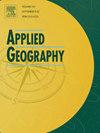青藏高原可持续发展目标时空动态评价
IF 4
2区 地球科学
Q1 GEOGRAPHY
引用次数: 0
摘要
评估可持续发展目标有助于深入了解可持续发展的挑战。然而,缺乏详细和最新的信息限制了我们对可持续发展目标QTP进展情况的全面了解。为了弥补这一差距,我们整合了多源数据,制作了2000年至2020年的高分辨率可持续发展目标映射,研究了可持续发展目标的动态及其在整个QTP中不断演变的相互作用。可持续发展目标得分呈东南向西北递减的梯度,高值区域集中在主要城市中心和QTP的南部和东南部地区。在过去二十年中,可持续发展目标得分稳步提高,特别是在东部、东南部和东北部地区。可持续发展目标得分超过50的地区的人口比例从38.68%上升到90%。不同海拔和坡度的可持续发展目标绩效均有所改善,其中低空和低坡度地区的进展最为显著。此外,SDG1、SDG4和SDG9在多个尺度上的相互作用强度增加,涉及SDG1的协同效应显著扩大。为实现区域平衡发展,未来战略应优先考虑呈现下降趋势的可持续发展目标,以及协同效应减弱或权衡加剧的可持续发展目标对,并实施有针对性的措施来应对这些挑战。本文章由计算机程序翻译,如有差异,请以英文原文为准。
Assessing spatiotemporal dynamics of sustainable development goals on the Qinghai-Tibet plateau
Assessing SDGs offers critical insights into the challenges of sustainable development. However, the lack of detailed and up-to-date information constrains our comprehensive understanding of SDG progress on the QTP. To bridge this gap, we integrate multi-source data to produce high-resolution SDG mappings from 2000 to 2020, examining the dynamics of SDGs and their evolving interactions across the QTP. The SDG scores exhibit a declining gradient from southeast to northwest, with high-value regions concentrated in major urban centers and the southern and southeastern areas of the QTP. Over the past two decades, SDG scores have steadily improved, particularly in the eastern, southeastern, and northeastern regions. The proportion of the population residing in areas with SDG scores exceeding 50 surged from 38.68% to 90%. SDG performance across varying altitudes and slopes improved, with the most significant progress observed in low-altitude and low-slope areas. Moreover, the interaction intensities of SDG1, SDG4, and SDG9 increased across multiple scales, while synergies involving SDG1 expanded significantly. To achieve balanced regional development, future strategies should prioritize SDGs exhibiting declining trends, as well as SDG pairs with weakened synergies or intensified trade-offs, and implement targeted measures to address these challenges.
求助全文
通过发布文献求助,成功后即可免费获取论文全文。
去求助
来源期刊

Applied Geography
GEOGRAPHY-
CiteScore
8.00
自引率
2.00%
发文量
134
期刊介绍:
Applied Geography is a journal devoted to the publication of research which utilizes geographic approaches (human, physical, nature-society and GIScience) to resolve human problems that have a spatial dimension. These problems may be related to the assessment, management and allocation of the world physical and/or human resources. The underlying rationale of the journal is that only through a clear understanding of the relevant societal, physical, and coupled natural-humans systems can we resolve such problems. Papers are invited on any theme involving the application of geographical theory and methodology in the resolution of human problems.
 求助内容:
求助内容: 应助结果提醒方式:
应助结果提醒方式:


